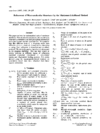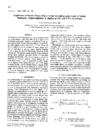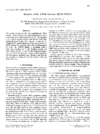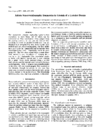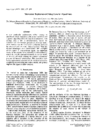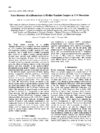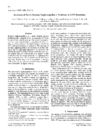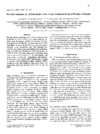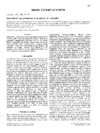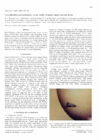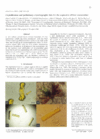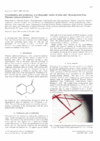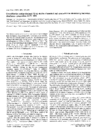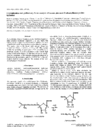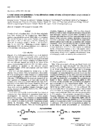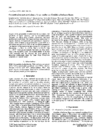issue contents
May 1997 issue

Cover illustration: View of interdomain interface of cell adhesion molecule VCAM-D1D2. The two hydrophobic patches (yellow from domain 1 and orange from domain 2) allow the domains to rock back and forth around the `pivot' residue Tyr89. The long C'E loop and FG loop seem to guide the movement. Courtesy of Jia-huai Wang.
research papers
Microgravity-grown and earth-grown control crystals of apo-crustacyanin C1 are compared via rocking curves and a plot of mosaicity versus reflection peak/backgound. Crystal movement, probably arising from Marangoni convection from the use of vapour-diffusion geometry in microgravity, may be the cause of inconsistencies in protein crystal quality, although the best crystal was microgravity grown.
The likelihood function used for refinement of macromolecular structures is extended to include prior phase information, experimental uncertainties and different weighting for well and poorly defined parts of the structure, thus reducing refinement bias, is described. Results obtained from the implementation within the program REFMAC are given.
Xylanase from Erwinia chrysanthemi was crystallized in the absence and presence of polymeric substrate in forms suitable for X-ray analysis. Preheating of protein samples to 323 K in both cases enhanced crystal quality and reproducibility.
The structure of this protein could be redetermined with data at a resolution in the range 1.55-1.75 Å, using direct methods based on about 100 known triplet phases. A new figure of merit showed very good properties in guiding phase refinement and structure modelling in the early critical stages. (See erratum Acta Cryst. (1997). D53, 626.)
The crystal structure of the DNA octamer d(GGCATGCC) is an A-DNA duplex with Watson-Crick base-pairing interactions between two self-complimentary DNA strands. The helix axis curvature is 7°.
NDB reference: adh078
Three protein crystal forms are described that appear to grow from fibers. One fiber type forms sheets that aggregate readily with low symmetry, but can be forced by an inter-protein bond to a highly symmetric association. In one case the fiber introduces an exact twofold screw axis that is infinite but non-crystallographic.
A new molecular replacement strategy is introduced which features a continuous transform and a genetic algorithm (GA) for search optimization. This strategy uses a GA to simultaneously search the rotational and translational parameters of a test model while maximizing the correlation coefficient between the observed and calculated diffraction data.
The X-ray crystal structure of the complex of uridine vanadate and bovine ribonuclease A was refined and compared with other structures of ribonuclease complexes.
The refined structure of soybean leghemoglobin a nicotinate is compared with the structures of lupin leghemoglobin II and sperm whale myoglobin. The distal heme cavity is larger than in myoglobin. The existence of two channels by which exogenous ligands may reach the heme is confirmed.
PDB reference: 1fsl
The 1.8 Å crystal structure of an active form of porcine α-trypsin is reported. There is a small but systematic directional chain shift around the active site residues from active to inactive to inhibitor complexed crystal structures of porcine trypsin.
PDB reference: 1aks
Detailed analysis of the occurrence of C-H⋯O hydrogen bonds in β-sheet regions of proteins is presented. These hydrogen bonds including those involving side chains appear to additionally stabilize the structure.
C-Phycocyanin (C-PC) and allophycocyanin (APC) from Spirulina platensis have been purified and crystallized by the gel-acupuncture technique. The crystals of APC belong to space group P6322 and C-PC crystals belong to either space group P6 or P63.
short communications
Two crystal forms of a chemically synthesized D-monellin consisting of all D-amino acids has been crystallized. Neither crystal form is identical to that of natural L-monellin.
Mouse tumor necrosis factor has been crystallized in space group P1. Crystals are flash frozen during data collection and diffract beyond 2.0 Å resolution.
A new cellular growth factor termed augmenter of liver regeneration has been crystallized in space group P21212 with a = 125.1, b = 108.1 and c = 35.8 Å.
A chromoprotein from Pleurotus salmoneostramineus has been purified and crystallized to give a needle-shaped crystal in space group C2. The crystal diffracts to 1.8 Å resolution with synchrotron radiation.
Two distinct azurins from the denitrifying bacterium Alcaligenes xylosoxidans have been crystallized. The preliminary X-ray studies of the two azurins have been performed.
S-adenosylhomocysteine hydrolase, a key enzyme involved in the regulation of transmethylation, has been crystallized. The tetrameric molecule exhibits 222 symmetry.
Crystals of tulip aryl acylamidase have been obtained by the vapor-diffusion technique. the crystals diffract to 2.5 Å resolution and belong to space group P212121.
Ab initio quantum chemical calculations estimate C-H⋯O interactions to contribute 6% to the stability of the Watson-Crick adenine-uracil base pair.
Crystals of Candida cylindracea lipase have been obtained in space group P21. This structure has been solved by molecular replacement methods.
books received
Free 

Free 



 journal menu
journal menu










